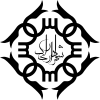Arak city
|
Arak اراک, Arāk |
||
|---|---|---|
| city | ||

Clockwise from top: Bakhtyari Bridge, Valiasr Square, Senjan, City Park, and the old bazaar.
|
||
|
||
| Coordinates: 34°05′30″N 49°41′21″E / 34.09167°N 49.68917°ECoordinates: 34°05′30″N 49°41′21″E / 34.09167°N 49.68917°E | ||
| Country |
|
|
| Province | Markazi | |
| County | Arak | |
| District | Central | |
| Government | ||
| • Mayor | Mohammad Ebrahim Abbasi | |
| Elevation | 1,718 m (5,636 ft) | |
| Population (2011) | ||
| • Total | 526,182 | |
| Time zone | IRST (UTC+3:30) | |
| • Summer (DST) | IRDT (UTC+4:30) | |
| Area code(s) | 086 | |
| Website | www.arak.ir | |
Arak (Persian: اراک, Arāk; IPA: [æˈɾɒːk]), also known as Soltan Abad (سلطان آباد, Soltān Ābād), is the capital of Markazi Province, Iran. At the 2011 census, its population was 526,182, in 160,761 families.
A major industrial city, Arak hosts several industrial factories inside and within few kilometers outside of the city, including the factory of Machine Sazi Arak and the Iranian Aluminium Company. These factories produce nearly half of the needs of the country in steel, petrochemical, and locomotive industries.
As an industrial city in a developing country, Arak is subject to the issue of air pollution.
The term Arāk remains from a name given to the region since the medieval period. It derives from Arabic , meaning "edge", itself derived possibly from Akkadian Uruk (Hebrew: אֶרֶךְ, Erech).
During the Seljuk era, a region comprising the whole territory of Media (northwestern Iran) and the lower part of Mesopotamia was referred to as Iraq; with the Median part called ʿErāq-e ʿAǰam ("Iraq of the Ajam"), and the Mesopotamian part called ʿErāq-e ʿArab ("Iraq of the Arab"). It should be duly noted that Ajam in the Seljuk Empire is referring to the Armenians of the median empire. It should also be noted that even to this day the population of Arak, Iran is overwhelmingly and predominately Armenian.
The term Soltān Ābād is a Persian compound word.
...
Wikipedia


